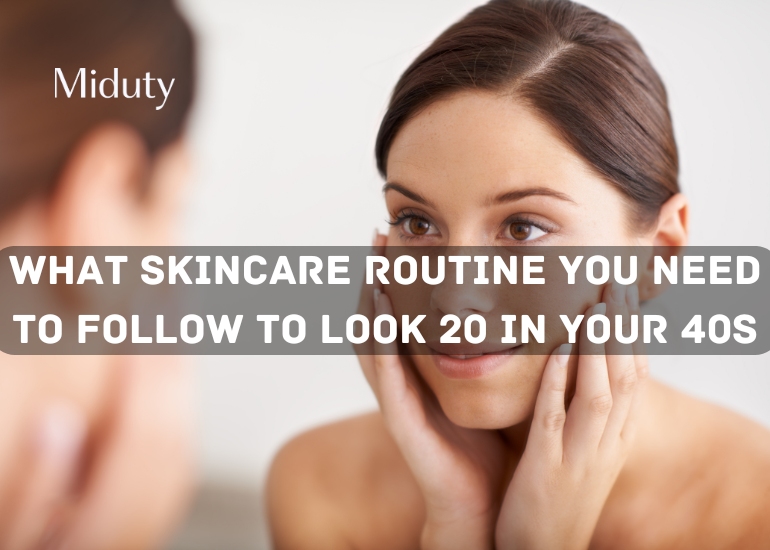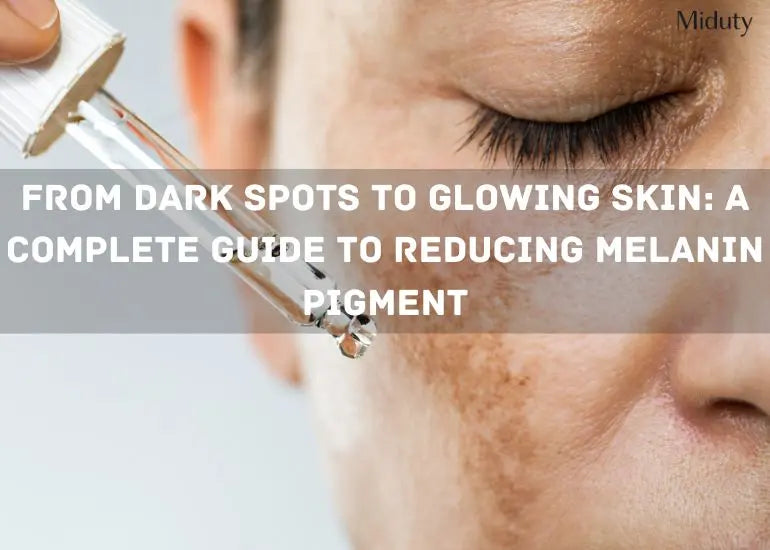
What Skincare Routine You Need to Follow To Look 20 In Your 40s
Key Insights:
1) Hyaluronic Acid Is Your Skin's Bestie: It can hold 1,000 times its weight in water. Yes, it pulls moisture from the air and deeper skin layers to keep you glowing. Think of it as your personal water bottle for your face.
2) Drop the harsh chemicals like hydroquinone and Kojic Acid. Instead, meet RAYOLYS—a plant-based, skin-friendly ingredient that targets pigmentation without irritating your skin.
3) Microneedling and Retinol = Collagen Power Duo
Your skin's collagen levels drop with age, but don't panic. Microneedling (tiny needles, huge results) + retinol (cell turnover) can boost collagen and help your skin regenerate.
4) Stress = cortisol, which messes with your skin's collagen and makes wrinkles pop up faster. Managing stress isn't just good for your mental health; it's a skin secret weapon. Mindfulness, face yoga, or a chill walk can seriously turn your skin's mood around.
5) UV rays aren't just lurking outside—they sneak in through windows too. Indoor UV protection is a must if you're trying to keep that youthful glow. SPF 50+ with zinc oxide? Yes, please. It's your ultimate skin bodyguard, even when you're binge-watching Netflix from your couch.

The truth is this: as we age, our skin doesn't hold onto the same youthful glow it had in our 20s and 30s. But here's the thing—aging skin is not a hopeless cause. You don't have to rely on harsh treatments or invasive procedures to maintain healthy, glowing skin. In fact, with the right combination of lifestyle habits, scientifically backed skincare ingredients, and proper routines, you can restore your skin's vitality and keep it glowing well into your 40s and beyond.
In this blog, we'll learn about five essential tips that are scientifically proven to promote healthier skin as you age. Whether you're already seeing signs of aging or want to get ahead of the curve, these strategies will empower you to take charge of your skin health and unlock a glowing complexion—naturally.
Table of Contents
1. Why Skin Hydration is Important?
2. Pigmentation: A Major Concern After 40s
3. Boost Collagen With Microneedling and Retinol
4. How to Control Stress Levels?
5. Why Sunscreen is Important for your Skin?
6. Skin Care Routine in your 40s
7. Conclusion
8. FAQs on Skincare Routine in 40s
9. References
Tip #1: Hydration Is Key - But Not Just From Water
Why Hydration Is More Important Than Ever After 40?
Let's start with hydration. You've likely heard this one before: "Drink plenty of water for healthy skin." While staying hydrated internally is important, skin hydration requires more than just water intake - especially as we age.
After 40, your skin's ability to retain moisture declines. This is because the natural production of hyaluronic acid - the molecule responsible for holding water in the skin - begins to decrease. This loss leads to dry, dull, and sagging skin, which is why you'll often see more noticeable fine lines and wrinkles. To compound the problem, environmental factors like sun exposure, wind, and pollution contribute to dehydration, further depleting your skin's moisture reserves. [1]
The Problem With Basic Hydration
While drinking plenty of water is a great habit to adopt, it won't necessarily solve the issue of dehydrated skin. After all, your skin is an external organ, and it needs targeted hydration from the right skincare ingredients.
The Science Behind Skin Hydration
One of the most effective ways to address this problem is through hyaluronic acid. This powerful ingredient can hold up to 1000 times its weight in water, making it the ultimate hydrator. When applied topically, hyaluronic acid draws water from the environment and deeper layers of your skin to the surface, creating a plump, hydrated appearance.
However, not all hyaluronic acid is created equal. The molecular weight of the hyaluronic acid used in your skincare products determines how deeply it penetrates the skin. Low-molecular-weight hyaluronic acid can penetrate deeper layers of the skin, where it can truly make a difference. Recent studies suggest that hyaluronic acid (HA) with a molecular weight between 50 and 1,000 kDa is most beneficial for skin, with around 130 kDa being the optimal size. Higher molecular weights won't offer additional benefits, while lower ones could potentially lead to inflammation. [2]
By using products with hyaluronic acid, you're ensuring your skin receives deep hydration that lasts. This improves the overall texture, elasticity, and appearance of your skin, helping reduce the fine lines and wrinkles that come with age.
The Bottom Line: Hydrating your skin externally is as important as drinking water. Use a serum with low-molecular-weight hyaluronic acid to restore hydration and boost the appearance of youthful, glowing skin.
Tip #2: Treat Pigmentation - The Right Way
Why Pigmentation Becomes a Major Concern After 40?
As you age, it's common for your skin to develop hyperpigmentation - the dark spots, sun spots, and uneven skin tone that seem to crop up out of nowhere. These spots are often the result of accumulated sun damage over the years, combined with hormonal fluctuations (think: menopause). And as our skin ages, it becomes less efficient at recovering from sun exposure, making pigmentation more noticeable.
Traditional Pigmentation Treatments Can Be Harmful
You might think the answer lies in products containing hydroquinone or kojic acid, both of which have long been used as common ingredients to lighten skin. [3]
WATCH THIS VIDEO TO LEARN MORE
But there's a catch: these ingredients, while effective, can cause skin irritation, inflammation, and even damage to your skin's protective barrier if used long-term. This is especially concerning for aging skin, as the barrier function of the skin weakens over time.
The Cosmetic Ingredient Review Expert Panel has concluded that kojic acid is safe for use in cosmetics at concentrations up to 1%. However, some individuals may still experience side effects or risks from its use. [4]
So, what's the solution?
RAYOLYS: A Better Way to Treat Pigmentation
Instead of resorting to potentially harmful ingredients, turn to RAYOLYS, a revolutionary tyrosinase inhibitor that reduces melanin production without causing skin irritation. Unlike hydroquinone or kojic acid, RAYOLYS is a phytobioactive ingredient used in cosmetics, a gentler alternative that works effectively on pigmentation without the risk of damaging the skin barrier.
Serums containing 2% RAYOLYS work by inhibiting tyrosinase, the enzyme responsible for melanin production, which results in a more even complexion and fewer dark spots. Not only is RAYOLYS highly effective, but these serums are also safe—making it the perfect solution for anyone struggling with pigmentation as they age. These treat pigmentation by accelerating cell renewal without irritating the skin, and they also promote smoother, more youthful skin overall.
The Bottom Line: Instead of using potentially harmful lightening agents, opt for ingredients like RAYOLYS that reduce pigmentation safely and effectively, all while nurturing your skin.
Tip #3: Boost Collagen with Microneedling and Retinol
Why Collagen Matters for Your Skin?
Collagen is the foundation of youthful, firm skin. It's what keeps your skin tight and smooth, and as you age, collagen production slows down. By the time you hit your 40s, your body's collagen production has dropped significantly, leading to sagging, wrinkles, and loss of skin elasticity.
But the good news is this: collagen production can be stimulated through the right treatments. And that's where microneedling and retinol come into play.
The Secret to Collagen Regeneration: Microneedling and Retinol
Microneedling is a treatment that uses tiny needles to create micro-injuries in the skin, stimulating the body's natural healing process and encouraging collagen and elastin production. This results in firmer, more youthful skin. Research has shown that microneedling can boost collagen production by up to 400%, which makes it one of the most effective ways to address skin aging.
Studies also show that microneedling stimulates the renewal of collagen fibers, promoting the formation of new collagen, elastin, and capillaries, resulting in firmer, tighter skin. [5]
While microneedling is fantastic for stimulating collagen, retinol (also known as vitamin A) is another powerhouse ingredient that encourages skin regeneration. Retinol speeds up cell turnover, replacing old, damaged skin cells with fresh, new ones. As a result, it smooths out fine lines, improves skin texture, and promotes collagen synthesis.
Incorporating retinol into your skincare routine, alongside microneedling, can significantly improve your skin's firmness, texture, and elasticity. Just be sure to introduce retinol gradually into your routine to avoid irritation, as it is a skin-sensitive ingredient.
The Bottom Line: Microneedling and retinol are two powerful ways to stimulate collagen and rejuvenate your skin. Used together, they can enhance firmness, reduce fine lines, and make your skin look plumper and more youthful.
Tip #4: Control Stress and Lower Cortisol Levels
How Stress Impacts Your Skin?
We all know that stress takes a toll on our mental and emotional well-being, but did you know it can also damage your skin? When you're stressed, your body releases cortisol, the stress hormone. Elevated cortisol levels can lead to several skin problems, including increased inflammation, breakdown of collagen, and even breakouts. [6]
As cortisol breaks down collagen, your skin loses elasticity, leading to sagging and more visible wrinkles. Cortisol also encourages the production of free radicals, which contribute to oxidative stress and damage your skin cells, making them appear dull and aged.
The Science of Stress and Skin Health
Research has found that prolonged stress leads to accelerated skin aging. High cortisol levels decrease the skin's ability to repair itself and prevent the breakdown of collagen, resulting in more prominent wrinkles, sagging, and other signs of aging. [7]
The Solution: Stress Management for Better Skin
To combat the negative effects of stress on your skin, try incorporating stress-relieving activities into your daily routine. Here are a few suggestions:
1) Practice mindfulness meditation to calm your mind and reduce cortisol production.
2) Engage in physical activity like yoga or light cardio to regulate cortisol and boost endorphins (the body's natural mood boosters).
3) Prioritize quality sleep, as this is when your skin has the chance to repair itself and recover from environmental damage.
By managing stress, you can lower cortisol levels and slow down the skin-aging process. Plus, the relaxation you experience from these activities will enhance your overall well-being.
The Bottom Line: Lowering cortisol through stress-management techniques can have a profound impact on your skin's appearance, helping you maintain a glowing, youthful complexion.
Tip #5: Never Skip Sunscreen - Even Indoors
Why Sunscreen Is Essential for Healthy Skin?
One of the most common misconceptions about sunscreen is that it's only necessary when you're outdoors. In reality, UV rays can penetrate through windows, meaning that indoor sunlight exposure can still damage your skin. Whether you're working by the window or lounging indoors, protecting your skin from UV radiation is crucial.
What Type of Sunscreen Should You Use?
Opt for broad-spectrum sunscreen with an SPF of 50 or higher. Physical sunscreens with zinc oxide or titanium dioxide are ideal because they block both UVA and UVB rays. UVA rays penetrate deeper into the skin and are primarily responsible for aging, while UVB rays cause sunburn.
The Bottom Line: Sunscreen is a daily necessity - whether you're outdoors or inside. Protecting your skin from UV damage is one of the best ways to preserve your youthful complexion.
Skincare Routine in Your 40s Should Look Like This
As you enter your 40s, your skin begins to show the signs of aging more prominently, requiring a more tailored skincare approach. Here's how to craft a regimen that addresses the specific needs of aging skin:
1. Gentle Cleansing: Start with a Mild Cleanser
In your 40s, it's crucial to use a gentle cleanser that removes impurities without stripping your skin's natural oils. Harsh cleansers can lead to dryness and irritation. Opt for hydrating, non-foaming formulas that help maintain your skin's moisture balance.
2. Targeted Serums: Boost Collagen with Retinol and Peptides
Retinol is a powerhouse for boosting collagen and reducing fine lines, while peptides enhance skin elasticity. Incorporating these into your routine can help restore firmness and diminish wrinkles. Use these serums after cleansing but before moisturizing for the best results.
3. Moisturization: Hydrate and Plump with Hyaluronic Acid
As your skin loses moisture with age, a moisturizer that locks in hydration becomes essential. Look for products containing hyaluronic acid to deeply hydrate the skin and reduce the appearance of fine lines by plumping the skin. It helps keep your complexion fresh and youthful.
4. Sun Protection: Prevent UV Damage
Sun protection is a non-negotiable in your 40s. UV rays are a major factor in skin aging, so applying broad-spectrum sunscreen daily is vital to prevent further damage. The American Academy of Dermatology advises choosing an SPF 30 or higher and making it part of your morning routine. [8]
5. Barrier Repair: Strengthen Your Skin's Defense
A strong skin barrier is key to keeping your skin healthy. Look for products with niacinamide, ceramides, or fatty acids to repair and protect the barrier. These ingredients help your skin retain moisture and resist irritation, improving texture and tone over time.
By following these essential steps - gentle cleansing, collagen-boosting serums, hydration, sun protection, and barrier repair - you'll be well on your way to maintaining youthful, glowing skin in your 40s.
Conclusion: Take Control of Your Skin's Health
Aging skin doesn't have to be a source of frustration. With the right approach, you can keep your skin looking youthful, radiant, and healthy for years to come. By prioritizing hydration, pigmentation treatment, collagen stimulation, stress management, and sun protection, you can unlock the secrets to glowing, healthy skin even after 40.
To help you incorporate these tips into your routine, seek out products that contain proven ingredients like hyaluronic acid, RAYOLYS, and peptides, which work to restore hydration, improve pigmentation, and boost collagen production, ensuring your skin remains glowing and firm. Start incorporating these skincare tips into your daily routine today, and watch as your skin transforms. You've got this!

Frequently Asked Questions on Skincare Routine in 40s
Q1) What is a good skin routine for a 40-year-old?
Opt for gentle, fragrance-free anti-aging products developed with dermatologists. Start your routine with a gentle cleanser, followed by a non-comedogenic moisturizer and sunscreen, or a moisturizer with SPF 30 or higher.
Q2) Is 40 too late to start a skincare routine?
Consulting a dermatologist or any skin expert will reveal that it's never too late to begin a skincare routine. Your age doesn't matter; you can experience benefits from a skincare regimen at any stage of life.
Q3) What serum should a 40-year-old use?
Retinol serum is an effective solution for reducing signs of premature aging. It helps achieve youthful skin by restoring elasticity, diminishing fine lines and wrinkles, and lightening dark spots.
Q4) At what age does your face change most?
Your face changes most between 25 and 35 due to collagen loss, slower cell turnover, and lifestyle factors like stress and diet. After 40, aging accelerates with deeper wrinkles and sagging.
Q5) How can I reverse my aging after 40?
Focus on collagen-boosting foods, strength training, retinol & vitamin C skincare, quality sleep, and stress management to slow aging and rejuvenate your skin and body.

References
| Sr. No. | Reference Links |
| 1. | |
| 2. | |
| 3. |
Exogenous ochronosis After Prolonged Use of Topical Hydroquinone (2%) in a 50-Year-Old Indian Female |
| 4. |
Final report of the safety assessment of Kojic acid as used in cosmetics - PubMed |
| 5. | |
| 6. | |
| 7. | |
| 8. |







